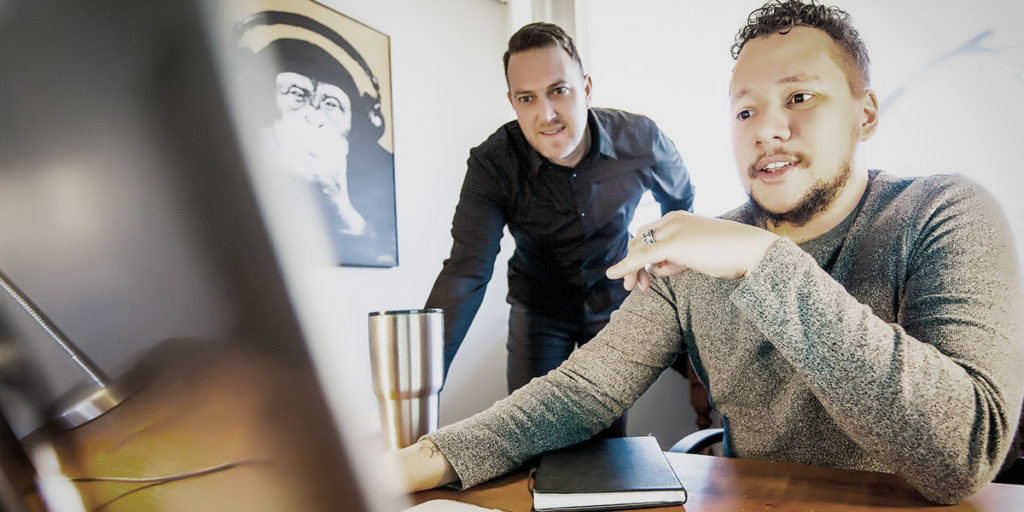Ep. 50 CTM in Review with Dominick Montgomery and Brad Post
Brad Post, Create the Movement
Dominick Montgomery, Create the Movement
Brad Post, Create the Movement: Welcome back to Create the Movement podcast. This is a very exciting episode. Right?
Dominick Montgomery, Create the Movement: It is.
BP: This is Episode 50. This is Brad Post, and I’m sitting here with our Chief Marketing Officer Dominick Montgomery.
DM: How’s it going guys?
Merger and Building the CTM Team
BP: He’s usually always pretty busy, so it’s hard to get him on a podcast. So, I put him in a headlock and we came into our office and we’re going record Episode 50 together. Dominick, we’re going to talk a little bit about our past year, our year’s growth last year, and the ups and downs of our business. It was a quite a year. You guys, you and Liz, started with us, or we combined forces in January, officially.
DM: Right.
BP: I think Liz was working with us a little bit, and you and I were chatting. Dominick and Liz had a marketing company and we had a marketing company. We decided to do a permanent collaboration is what we’re calling it. Right?
DM: That’s right.
BP: I think January we had our office, right? And I think you and Liz were coming in and growing a team at the same time. We had a team on board. I remember when we communicated that you guys we’re coming on board, they were like, “Yes! Dominick and Liz?” It was just like a natural.
DM: Right.
BP: Tell me what you guys were feeling.
DM: Yeah, same thing, man. We were in our growing phase and we were bringing on sales people and offering them what we could offer at the time. It just felt right to bring everything into one fold and work as a team together.
BP: I agree. I remember Dominick and I had history together, and Liz, when we worked at a different company together, which we won’t mention. We combined forces again. I remember you coming up and consulting with with our team. And you going, “Man, I’ll pay you for the consulting.” You brought coffee and everything. You’re like, “Man, don’t worry about it.” You spent an hour with our team and you did that, I think, a few times. That’s why our team was so
DM: Welcoming.
BP: Yeah, welcoming and exciting. You were working with David at the time.
DM: That’s right.
BP: And David was coming into the staff meeting and stuff like that. It was an exciting time. We quickly grew. So, you guys came on and brought your sales team. We had probably four or five. And they were commissioned-only sales people at the time.
DM: They were like a rag-patch crew of people.
BP: Great group of guys, but it totally changed the dynamics of our office pretty quickly.
DM: Yeah.
BP: Because, I think you guys were coming in. We had six people in our sales floor. We came in on one weekend, I remember, and put all those desks together.
DM: Yeah, we had a bunch of IKEA desks.
BP: Right. It was exciting, however, we quickly realized that company culture was shifting. We needed to reign those guys in a little bit. We brought on an amazing guy and he took over the sales team, and really ran with it. We had a lot of growth. We took on a lot of accounts last year.
DM: Yeah. Those guys were hustling. They were working leads like crazy. And the guy that we brought on, he would not take ‘no’ for an answer.
BP: Right.
DM: If somebody said, “Don’t call me any more.” He’d say, “Okay, well does that mean this week? Because I’m going to call you again.”
Creating the Process
BP: Neat and a growing pain for us was we took on a lot of accounts that we shouldn’t have. Do you agree?
DM: Yeah. That’s big. We took a lot of accounts that we knew we could do the work, but we weren’t well versed in. And we had a lot growing pains in that we had to figure out how to work as an agency with people who weren’t used to working with an agency.
BP: Right.
DM: We usually work with with attorneys who are used to a marketing firm, or an ad agency, or something like that. But when we start getting into other industries, other markets, a lot of times they’re just used to working with their nephew, or their cousin. And they get to pull the strings and tell them exactly what they want. It was hard for us to bring people on and expect them to fall in line with how we do business. So, that was a big growing pain – just figuring out how to create a process so that no matter who we sold to they would conform to our process. So that they would have a good time, and more so, we would have a good time.
BP: Right. Because we were taking on accounts that we probably, we were okay to take on, we just didn’t price them right.
DM: Yeah, that too.
BP: Sales guys were like, “Hey, let’s just charge this.” And we felt bad going back and saying, “Hey, you need to, I know you sold this, but you need to go and charge them more.” So, we did a lot of, I’d say, free, or not free work, but
DM: We did a lot of free work, actually.
BP: Right.
DM: Or, work that we paid to do.
BP: Yes! Exactly. Non-profitable work. But you talking about the process. So, probably mid-year till the Third Quarter we set up the process.
DM: The process took awhile to set up just because you have to have the right people. You have to have the right number of people. And then, you have to the right tools in place.
BP: Exactly.
DM: So, we found a great tool that allowed us to do a briefing with our clients. So, that was step one. Step two was bringing in a consultant who had a birdseye view of what we were doing and was able to say, “Hey, have you ever tried this? Have you ever tried that? I feel like this will save you time.” And he came up with a great idea that saved us a lot of time actually when it came to development. And then, like I said, having the right people in place who can replicate and duplicate the process.
Once we got all of that into place things started flowing really smoothly. Not everything’s perfect all time, but it’s a lot more smooth with a process in place. I think we had an influx of clients last year, maybe mid-year. We had a lot of projects on the board.
BP: Twenty, maybe? Twenty-five?
DM: Twenty, thirty projects on the board. And I remember looking at the board like, “Man, every client is in a different place.” Meaning in a different place in their development process. And just realizing, “Man, we need to be able to say, ‘Okay, that client’s in at the 60% stage. Or, this client’s at the 20% stage.’” But when you don’t have a process for development, or a process for marketing, you just say, “Hey, we did that for the client and there’s no start or finish point for that client on the board.”
That’s what we figured out and it works. We’re really happy that we have that now.
BP: It was, I wouldn’t say slow going, but I think you and I, and I’m not saying we were the masterminds behind it, we were like, “Okay, let’s set down this is step one. And step one’s the phone call with the client after we sign. And step two is the marketing, the visual brief. ‘Here’s what we heard from step one.’ And then step three was coming up with the home page design.” Which I think we were probably still around the 95% home page design approvals. Because last year we’d show them the home page and they’d be, “Okay, cool.” And then we’d go to lunch and they’re like, “No, we want you to change this on home page, and this on the home page.” And we’re thinking, “We’ve already got it approved.” So, we set up an approval process where they ‘click.’ Right?
DM: That’s another thing. Yeah, we set up approvals along the way. So they approve this, we send them a form. They say, “I approve it.” They approve the home page, “I approve it.” They approve us to launch it, “I approve it.” We always keep that so that, not saying clients are going to come back and do anything, but some clients are picky and they want to always have a say in whatever. Some personality types are just like that.
So, we use that to combat when a client says, “I don’t remember approving that.” Or, “I don’t remember that about it.” And we say, “Hey, you approved it and we went ahead and built it.”
BP: And we have excellent customer care here, too. Your heart, and my heart, is we want to provide them. So, if they come back with a change, for the most part, last year we’re, “Okay, no problem.” And the next thing you know three, four hours later you and Dave are like, “Okay, got it done.” And we’re like, “We didn’t scale, or we didn’t price out that extra addition.”
DM: I think that speaks to another point, too. Over the year we’ve been able to value ourselves more. Take more pride in what we do. I think we’re comfortable with charging more. We upped our prices.
BP: We did.
DM: I think we’re comfortable with that because we’ve set standards and processes in place, and that makes us feel safe and we know it makes the client feel safe.
BP: We’ve even sold deals based on our process.
DM: Right!
BP: When clients coming to us going, “So, tell us what do you do?” And we gave them the whole line out. And they’re like, “Wow! How big are you guys? That’s great.” We’ve sold a lot of deals just based on our process alone.
DM: That, and the customer service. Whoever is listening, you’d be so surprised at how important just a reply to an email is to some clients.
BP: Yup. In a timely fashion.
DM: In a time fashion, right. We had a client who said her current company just wouldn’t reply. And the fact that she can send us over, “Hey, I need this blog posted.” And we reply with at least, “Okay, got it.” Makes her happy. She’s going to be a client forever.
BP: Yup. Exactly.
DM: So, we’ve tweaked our customer service as well. That has filtered through the team, so now the team is on it. It’s awesome to see if a client has a question they get a lengthy response that makes sense, not just a two sentence email. That makes me happy.
BP: I think the neat thing at our prime last year we were probably 14 employees. We’re back down to nine in office and then three out of the office, so 12. But 14 in-house? It was crazy. You had an office for four people. I had an office with three people.
And then, we went through a tragic loss last year. October, I believe it was. Not to share a lot on that story, but a tragic loss. We lost one of our greatest employees. One of our greatest friends. Coming together after that happened, I think we made the call we were like, “Hey, you guys if you want to come to work you can this week. If not…” But we all came pretty much every day. Had a counselor in. We grieved through that process.
DM: That’s what tightened up this core team. And you can talk more towards the core team, but the fact that you said that. We were like, “Hey, no. Don’t come in this week.” I remember saying, “Stay home.” to some people. Just stay home, don’t come in. And everyday we all just wandered into the office.
BP: We did. Just at random times. We just wanted to work.
DM: We just wanted to be together.
BP: Yeah.
DM: Which was really amazing and spoke a lot towards the heart of the people who work here.
BP: And that’s where we got our core team of where we’re at now. And we’ve even talked about growth and what growth looks like, and we’re very strategic about our growth. We’re always looking for good people, but we won’t make a quick decision to hire someone just because we feel like we need them. The work’s got to be there. We’ve got to know that they fit the culture of the company before we do that.
DM: Right. I think one of the smartest you ever did was when we bring someone on, and we interview them. Here’s what Brad does. He’ll interview the person with Stacey, and then he’ll call them in for a second interview with two other people from the company. And it’s brilliant because two other people, we’re a small company so if you get four voices, four opinions about a certain person that’s usually the majority of the company.
BP: Right.
DM: So, he’s depending on his own perception of a person to make the call. He’s depending on the perception, or the opinion, of a lot of people. And, a lot of times it’s the right call when three people say they’re not a good fit. Okay, we’ll then they won’t be a good fit.
BP: The one person out of the four…
DM: There’s one person – what’s your issue with the person? You can get over that. Sometimes.
BP: I think because I really value other input because if we bring on a new employee it could disrupt the whole culture because we have had employees in the past that have disrupted the entire culture.
DM: Yeah, we have.
BP: And it hurts, and it’s hard, and it makes work not fun to come into. I think we’ve started doing in the past probably three or four months is have weekly vision meetings. So, we developed our core team and then we all come together because every single one of us, just about, is in a different department handling something different. We try to limit meetings down to not very many. But just a weekly vision meeting where we go through a book right now called ‘Ultimate Productivity.’ We go through a chapter a week. And it’s pretty much without fail. If I go on vacation, then Dominick normally would lead it. We tell somebody if it’s their one-year, or if somebody had a birthday, or whatnot, we celebrate it. Talk about wins for the last week.
DM: Just try to lift everyone up.
BP: Yeah. One thing I was going to mention, too, going back to the new hire process, it’s new to us, but the past few employees we’ve done the 45-day boot camp.
DM: Yeah. Our 45-day boot camp is intense, guys. No, it’s not. We put together a CTM Create the Movement Certification where what we want to do is train a person up in what we do and the industry terminology and our way of thinking.
BP: Right.
DM: We came up with a 50-question test, and when a person comes on we have them take the test blindly. It’s just, “Hey, take this test. We just want to see where you’re at.” A lot of the times they get 40 out 50 wrong. So, then we can gauge this 45 days is going to be intense. This person needs to learn a lot. And then, our goal is by the end of that 45 days they know every answer to every question on that test, and they’re beginning to thrive in their position – whatever that may be.
BP: Exactly.
DM: If those two things aren’t met, if we’ve taught them everything and they haven’t learned it or haven’t cared to learn, or they’re not thriving in their position, then we get to say, “Okay, maybe you’d be best suited elsewhere.” And it sucks to do. But Brad’s really good at referring people to other places they could go.
BP: We do weekly check-ins during the 45 days. So, the last few, if they’re not going to make, and internally we talk as a team, as an executive-management team. We’re all on board, “Yeah, they’re not going to make it.” We have those difficult conversations running up to the 45 days, so if they don’t make it, then they kind of know and it’s an easier out. Or, they have a good idea that they know they’re going to make, and they so they can continue to thrive in their position, continue to learn more past the CTM Certification. Because we had one guy pass it with flying colors and we had another person that didn’t really work. But her departure was still a great process out.
DM: We’re good people.
Reactive vs. Proactive
BP: Right. One last thing, so we learned last year when we took on a bunch of clients, took on a bunch of employees, we were very reactive.
DM: Yes.
BP: Okay, got a new employee, let’s write an employee manual. We’ve got a new sales person, we need to write a sales manual. Right? And so, we got 10 new clients, well we need to write an operating manual on how to take on these 10 clients. We were very reactive, and now we’re proactive.
DM: We weren’t just reactive in our physical business, we were reactive with client requests, too. We were reactive with giving someone time if someone said, “Hey, I want to meet with you guys about a website idea.” Okay, we’d set the appointment and not even really go into, “What’s the meeting going to be about?” Because we’re all busy. I think a few times we had quite a few meetings last year where we walked out and we were like, “Uh, waste of an hour, or two hours, or three hours. Man, that person didn’t have it together. They don’t have a clue what they want. They don’t have a budget at all. They thought we we’re just a charity that would help them out.” A lot of times we’d give them valuable information during those meetings. But, we’d walk out like, “We neglected our clients for three hours for this person.”
BP: Exactly.
DM: So, now we’re really specific with who we meet with, when we meet with them. Brad taught me when I first came on that I wasn’t a ‘calendar’ guy. I was more a ‘when it happens it happens’ guy. But calendaring your stuff is the most important thing ever. Setting your day up, even if you calendar ‘8-9: Eat Breakfast.’ You have to carve out the time for yourself, or it’ll be 8:15 and you’ll be answering emails. Whether it be for your life, or for business, or portions of business, scheduling out everything is the most important thing you can do.
BP: Thank you, man. I think one thing that you and I realized towards the end of year was, you and I, as the CEO and the CMO, were being brought into just about every single meeting. And we would say ‘yes’ to every meeting, like you said. And so, we actually developed some hoops to jump through in order to meet with us. We set up Calendly. So, they can go and set an appointment with us Calendly, as long as they follow that process. We’ll set up an UberConference with them. Or, a come to our office meeting.
We were traveling to all these different meetings and we started setting up more parameters. Like being invited to sales meetings, “Okay, what’s their budget? What are they looking for?” And if those questions aren’t answered, then we’re like, “Do both of us need to be in that meeting? Do we need to get the whole team on that meeting? Or, can it just be one person?”
DM: Yeah. If it’s a low budget, we’ll say, “Okay, I think you can handle this.”
BP: Right. Yeah, exactly. Setting up those parameters so that we don’t neglect our customers, or existing clients, for three hours. But if we feel like it’s going to be a good fit, they have the budget, looks like a good prospect, then yeah, absolutely we’ll meet with them.
But I think setting up those parameters and boundaries to meet with us, even internally. To meet with you, I scheduled this podcast two weeks ago. Right? Added it to the calendar and I’m I like, “Yes! He accepted.” And then you invited me to talk about the topics prior to having this. So, even internally scheduling time so it’s not like, “Hey, Dominick, you got a minute?” And you’re like, “No, I don’t.” And it didn’t hurt my feelings. I know you’re doing something.
DM: I remember going to a sales meeting with, I think, it was a Realtor and it was three hours long.
BP: Oh, wow.
DM: And the guy said definitely he’s going to come with us. I have never talked to that guy again. I’ve never seen him again. I always think about that meeting because it was so long. It was like the longest meeting I ever sat through!
BP: During a three hour meeting you probably came back to the office to 15-20 emails.
DM: Tons. Yeah.
BP: And two hours worth of work that you didn’t think would be an hour. So, you’re behind two hours on work.
DM: Yeah, the phone was buzzing the whole time during the meeting. Trying to explain to this guy AdWords.
BP: And I think we’ve even tightened up on potential new client meetings.
DM: You started putting on the proposals how much time they get.
BP: Right. With the development.
DM: Yeah. I love that. Brad has his initial call and then he puts ‘30 minutes.’
BP: Right.
DM: That’s awesome.
BP: We don’t track it that hard, but it’s usually 15-30 minutes. I think the clients that are going to steal three hours of our time aren’t our clients.
DM: Right.
BP: Because they don’t value our time.
DM: Exactly.
BP: And so, them thinking, “Hey, let’s just have a three hour potential sales meeting.” You know what? We walk away from that going, “We don’t want that client because they’re marketing brief call may be three hours.” And we don’t have three hours, or we charge them for it.
DM: Exactly. Now, if they came in and they had a $500,000 budget three hours is okay.
BP: Yeah, exactly!
DM: We’ll spend three hours with you.
BP: So, externally, customers value our time. And also internally, employees, our teammates, value our time. I think we’ve started to tighten up that process.
DM: It brings about a certain amount of respect for everyone here, too. Even if we brought in a 17-year-old intern, and we said, “Hey, man, do you have time at 2 PM today?” That shows a little bit of respect, I feel like. Instead of saying, “Hey, come here. I want to show you this.”
BP: Yes. Exactly. That filters throughout the company, too. Everyone’s checking each other’s calendars and valuing each other’s time, for the most part. It doesn’t mean to say we don’t occasionally have a five minute chat meeting.
DM: Yeah, we have hallway meetings all the time.
BP: Right. Water-cooler meetings.
DM: After we have a call with a client you hear four doors open.
BP: Exactly! And there’s either a high-five, or there’s, “Okay, what do we have to do to fix it? We need to have a meeting after this.” Most of the part it’s high-fives. It’s good. Clients are happy.
CTM in 2017
BP: Let’s talk about the future. Where we’re going – 2017.
DM: Yeah. I’m super excited about this year. I feel like we’ve hit a good stride. I feel like we’ve all got our heads wrapped around what we do and what we do best. I feel like we’ve been able to look forward instead of paying attention to what’s right in front of us. Which is huge because now we’re looking at, “Okay, well what if in three or four years the industry changes, where will we be? How do we start proactively pivoting so that we’re still relevant.”
BP: Either learning new services, or selling new products.
DM: Right. You’re very very proactive with team building and leadership and shaping the company vision. Which is awesome because companies change all the time, and I’m not a fan of companies that don’t change. I once worked for a company who only did digital, but claimed to not be an online company. Claimed to not be a digital company. Wouldn’t compare themselves to Apple. More so wanted to compare themselves to Sears. And it was ridiculous. It didn’t make sense.
We’re being really proactive with that. Looking towards the future, and looking at taking care of our core team. Our core team is so valuable to me and Brad, I know. And just making sure they feel loved, they feel appreciated, making sure that they don’t feel like they’re working all day. If that makes sense.
BP: Right.
DM: That they have a life. I’m excited.
BP: We do the weekly vision meetings. We do the monthly luncheons. We’ll bring in lunch and cast vision and have a good time.
DM: Don’t you mention pool. Don’t mention pool.
BP: We do quarterly outings. I was going mention quarterly outings that are optional. We make it optional and everyone shows up.
DM: All the time. Every time.
BP: We do something fun. We go bowl, or we’ll go play pool.
DM: Don’t you mention pool.
BP: Dominick’s a little sore about the last time we played pool.
DM: Brad beat me.
BP: In the finals, yeah, of the bracket. Just having a good time as a company. Bringing everyone together and enjoying what we do.
DM: Everyone enjoys each other. It’s awesome. And it’s family-friendly. People bring their kids. I’ve had my seven-month-old in my office one time for two hours while my wife met with Brad about something.
BP: And then he came in one other time, and you were needing to meet, and Liz was meeting with someone. So, I took him and I was just carrying Elijah around the office knowing that, “Okay, Dominick’s got to something for me that I can’t do.”
DM: You were!
BP: Liz had an interview, I think. Yeah, we came together.
DM: That stuff’s awesome. That doesn’t happen in traditional companies. I remember being at a company and I was showing them a video of a company in Los Angeles, a digital company. In the video they had, you know how some offices have office pets? You have your dog, or your cat, or whatever. I remember at this company I was at, which is why I’m no longer there, people said, “I would never let an animal into the workplace.”
BP: Wow!
DM: I was like, “Oh, man. That’s so not fun.”
BP: Exactly.
DM: But we make a big effort. And I feel like this year we’re making even more strides, too. Protecting what matters to us as people, and as leaders in business.
BP: Just changing and innovating to make sure that our company withstands in five years, and in ten years. Because we’re both pretty young guys. We still have quite a bit of life ahead of us. And we’ve both got kids, too, that we want to make sure that our kids don’t grow up hating our jobs, or our careers, or our business.
DM: Right. And worse, we don’t want them growing thinking that in order to run a company you have to work 80-hours a week.
BP: Yeah, exactly.
DM: There are more efficient ways to do it. And I think that’s what we’re working towards.
BP: Absolutely.
DM: Absolute efficiency.
BP: I think one thing that’s been good, too, is just the visions. When we look on a taking a new client that’s outside of our core existing clients, which are mainly attorneys, and it’s a new project, and somebody comes with a new idea and there could be profit in it. We put it back to the vision, “Hey, does this fit a vision of where we’re going? Can we provide effective marketing services? Efficient solutions? Excellent customer care?”
DM: We have to turn down a big deal, guys. A big deal.
BP: Yes.
DM: I remember sitting in your office, Brad, and you looked at me and you were like, “Should we turn it down?” And I said, “I don’t know? I don’t know.” Because you have a big-money price point looking at you, and Brad made the call and said, “You know what? This doesn’t fit what we do.” And wrote the email and said, “I’m sorry. It wouldn’t be responsible for us to take this deal. I can refer you to other people if you’d like.” And they came back and said, “We much rather work through you, refer us to someone.”
BP: Yeah, right.
DM: That was cool because we got to start looking at a referral kick-back, or something like that. But, smartest thing ever because had we gotten into that deal, had we been reactive like we were all of last year, we would have taken that deal. We would have been like, “Man, this is a lot of money. We’ll figure it out.” But, to be at a point where we can say we know; we can look at that and see that that’s going to take way more time than we have available. And, even thus a big price point, it’s not worth that much to us.
BP: Right. And we even questioned it for weeks after. We were like, “Should we have taken that?” We even had a tough month that month, too, and we questioned it. But, last year we had a few tough months and that’s when we just lowered our price, and cut deals and discounts, and everything. And just went through the process of people not valuing our services.
DM: One thing, and this might be wrong, and if it is we can ‘x’ this out of the podcast. But, what we found is that is in business the more you give someone for free, or the more you do something out of good faith – “They’ve been a good client I’ll do this.” The more you do that for a client the more it seems like they ask more of that from you. And what we found, I think what Brad was getting at, is that you have to value your work so much that even if they say, “Hey, I want this font a little bigger.” You say, “This is going to take an hour, or so. I’ll invoice you.” Or, maybe the first time you don’t. One thing that Stacey does is we do something she’ll send a ‘dead invoice’ where it shows it would have cost had we been a company that charged them. I would encourage everyone, if you’re listening to this and run an agency or you’re a solo entrepreneur, if you do something for somebody let them know how much you usually charge for it. So that they know it’s not just a quick favor. You’re using part of your time where you could be working on other clients and getting paid.
BP: That’s a lot of what we learned last year was just valuing our time. And then you’ll have a lot clients that’ll come in and say, “Hey, I’ve got this bigger, better deal. So, if you do this for me, then I’ll open you up to this bigger, better deal. Or, these other companies.”
DM: Or, “I have a lot of companies who I can refer you to.”
BP: Right. Yes. I would say steer clear of those people, or charge them more. I think we’ve all had those type of people where they’re like, “I’ll refer all my friends to you.” And then we get blinded thinking, “Man, they’ve got a wide network. They could refer us to all these other people.” And it never happens.
DM: And then they keep it quiet because they don’t want the other people know who worked on their stuff.
BP: Right. Anyway, I’m excited about 2017. 2016 was a year of growth. A year of just internal growth, external growth, it’s been exciting Dominick. I’m looking for years to come with you.
DM: Absolutely. This was fun. Thanks guys.
BP: Thank you guys.









